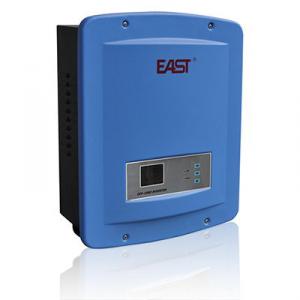240V On Grid Solar Inverter GW100K-MT
OKorder Service Pledge
OKorder Financial Service
You Might Also Like
Central solar inverter GW100K-MT inverters have wide application in commercial and industrial rooftop projects and small/middle size commercial solar power plants. The inverter adopts mature transformer isolation technology which minimizes output DC component effectively; advanced LVRT technology can meet any requirement of power plant grid integration, the products can be installed and applied in all types of grid network. At the mean while, the harsh quality testing and production system of the company provide strongest safeguard for 'GoodWe quality', product stability and reliability.
Datasheet

- Q: How does the harmonic distortion affect the performance of a solar inverter?
- Harmonic distortion can negatively impact the performance of a solar inverter. It can cause increased heat generation, reduced power quality, and can lead to premature failure of components. Additionally, harmonic distortion can interfere with other electrical devices connected to the inverter, causing disruptions and potential damage. Therefore, minimizing harmonic distortion is essential for maintaining optimal performance and efficiency of a solar inverter.
- Q: Can a solar inverter be installed outdoors?
- Yes, a solar inverter can be installed outdoors. However, it is important to ensure that the inverter is designed to withstand outdoor conditions, such as rain, humidity, and temperature fluctuations. Outdoor installation should also comply with local electrical codes and regulations.
- Q: How does a solar inverter handle grid disturbances (voltage sags, swells, flickers)?
- A solar inverter handles grid disturbances such as voltage sags, swells, and flickers by continuously monitoring the grid's voltage and adjusting its output accordingly. When a voltage sag occurs, the inverter increases its output voltage to compensate and ensure a stable power supply. Similarly, during a voltage swell, the inverter reduces its output voltage to prevent overloading the system. In the case of flickers, the inverter rapidly responds by regulating its output to minimize any fluctuations and maintain a consistent power flow. Overall, the solar inverter's advanced control mechanisms enable it to effectively manage grid disturbances and ensure reliable operation of the solar power system.
- Q: How does a solar inverter handle voltage drop in long cable runs?
- A solar inverter compensates for voltage drop in long cable runs by boosting the voltage to ensure efficient power transmission.
- Q: Three-phase photovoltaic inverter grid, the use of phase-locked loop is what?
- Grid-connected inverter can be operated locally through the LCD screen, or through remote monitoring with dedicated monitoring software.
- Q: How is a solar inverter connected to the solar panels?
- A solar inverter is connected to solar panels through a direct current (DC) connection. The DC power generated by the solar panels is sent to the inverter, which converts it into alternating current (AC) power that can be used to power electrical devices or be fed into the grid.
- Q: Can a solar inverter be connected to a home automation system?
- Yes, a solar inverter can be connected to a home automation system. By integrating the solar inverter with the home automation system, homeowners can monitor and control their solar power production, track energy usage, and automate various energy-saving functions such as adjusting thermostat settings, turning off appliances, or scheduling energy-intensive tasks during peak solar production hours. This integration enhances the overall efficiency and convenience of managing solar energy within a smart home environment.
- Q: Can a solar inverter be used with a solar-powered electric vehicle charging infrastructure?
- Yes, a solar inverter can be used with a solar-powered electric vehicle charging infrastructure. A solar inverter converts the direct current (DC) electricity generated by solar panels into alternating current (AC) electricity that can be used to charge electric vehicles. This allows for efficient and sustainable charging of electric vehicles using the power generated from solar energy.
- Q: What is the role of ground fault protection in a solar inverter?
- The role of ground fault protection in a solar inverter is to safeguard against electrical faults that occur when an unintended ground connection is made in the system. It detects any leakage of current to the ground and quickly disconnects the circuit to prevent the risk of electric shock or damage to the equipment. Ground fault protection ensures the safety and reliability of the solar inverter, as well as the overall solar power system.
- Q: What is the difference between a string inverter and a microinverter?
- A string inverter is a central inverter that converts the DC power generated by multiple solar panels connected in series into AC power. On the other hand, a microinverter is a smaller inverter that is attached to each individual solar panel, converting the DC power generated by each panel into AC power. The main difference is that string inverters are used for multiple panels, while microinverters are used for individual panels.
Send your message to us
240V On Grid Solar Inverter GW100K-MT
OKorder Service Pledge
OKorder Financial Service
Similar products
Hot products
Hot Searches
Related keywords























